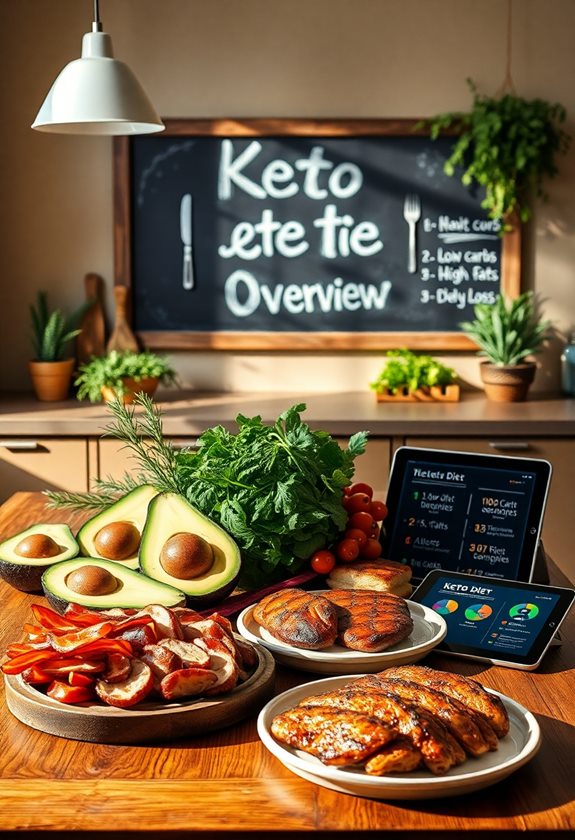When choosing between the Keto and Paleo diets, consider your personal goals and lifestyle. Keto focuses on high fats and very low carbs to help you lose weight quickly and boost energy. But, are you ready to count carbs? On the other hand, Paleo emphasizes whole foods, allowing fruits and veggies, which can feel more flexible and satisfying. What do you enjoy eating more? If you love avocados and nuts, Keto might be for you. If you prefer sweet potatoes and diverse meals, give Paleo a shot. Each path has its perks. There's much more to explore! 🍽️
Key Takeaways
- Assess your dietary goals: Choose Keto for rapid weight loss and energy or Paleo for balanced meals and whole food focus.
- Consider food preferences: Opt for Keto if you enjoy high-fat foods; choose Paleo for a variety of fruits and vegetables.
- Evaluate lifestyle fit: Keto requires strict carb counting; Paleo offers more flexibility with food choices.
- Take health conditions into account: Allergies or dietary restrictions may influence your choice between Keto and Paleo.
- Experiment with meal planning: Try both diets to see which aligns best with your taste and lifestyle for sustainable eating habits.
Overview of Keto Diet

The keto diet's primary goal is to shift your body into a state of ketosis, where it burns fat for fuel instead of carbohydrates. This means you'll eat fewer carbs and more fats. Sounds simple, right? But why would you want to do this? When your body is in ketosis, it can help with weight loss, boost energy, and even improve mental clarity. Additionally, incorporating meal replacement shakes like Keto Chow can provide nutritional completeness and help meet your dietary needs while on this plan. You might be wondering what to eat. On a keto plan, you'll focus on foods like avocados, nuts, seeds, and healthy oils. You can also enjoy meats, fish, and low-carb veggies. But you'll want to steer clear of bread, pasta, and sugary snacks.
It's important to listen to your body. If you feel tired or grumpy, it might mean you're not getting enough electrolytes. Many people share stories about how they felt the "keto flu" at first but soon enjoyed the benefits.
Overview of Paleo Diet
Paleo enthusiasts often embrace a diet that mimics what our ancestors would have eaten during the Paleolithic era. This means focusing on whole, unprocessed foods like lean meats, fish, fruits, vegetables, nuts, and seeds. By engaging in meal prep for success, you can enhance the effectiveness of this lifestyle, ensuring you have nutritious options readily available. You might wonder, why avoid processed foods? Well, many believe that these foods can lead to health issues, while our ancestors thrived on natural options.
The idea behind the Paleo diet is simple: eat what is natural and nutrient-dense. For example, instead of reaching for a sugary snack, you could enjoy a handful of almonds or a piece of fresh fruit. By choosing these foods, you're not just eating healthier; you're also connecting with a way of life that many find appealing.
You may also ask, what about dairy or grains? On the Paleo diet, these are typically avoided, as they weren't part of our ancestors' diets. But don't worry! There are plenty of delicious alternatives.
In short, the Paleo diet encourages you to go back to basics, focusing on real foods that nourish your body. Are you ready to give it a try?
Key Differences Between Keto and Paleo

While both the Keto and Paleo diets promote whole, unprocessed foods, they differ considerably in their macronutrient focus and overall approach to eating. You might wonder, what exactly sets them apart? The Keto diet is all about high fat, low carbs, and moderate protein. It aims to put your body into ketosis, where it burns fat for energy. On the other hand, the Paleo diet focuses more on whole foods that our ancestors ate, like fruits, vegetables, lean meats, and nuts, without the strict carb limits. Meal planning can enhance your experience with either diet by promoting healthier eating habits and mindful choices, which are essential for achieving your weight loss goals. Meal planning benefits emphasize improved time management and cost savings as well.
Think about it: with Keto, you're counting carbs to hit that low level, while with Paleo, you're choosing foods based on their natural origins. This means you can enjoy sweet potatoes or fruits in the Paleo diet, but they're limited in Keto.
Also, consider your lifestyle. Do you prefer a structured plan, or do you want more freedom in your food choices? Knowing these key differences can help you decide which diet fits your life better. So, which one speaks to you?
Benefits of the Keto Diet
When you immerse yourself in the Keto diet, you'll discover a range of benefits that can transform your health and wellness journey. This low-carb, high-fat way of eating may be just what you need to feel your best. Here are some key benefits you might experience:
- Weight Loss: Many people find they shed pounds quickly, as your body burns fat for energy instead of carbs. Who doesn't want that?
- Increased Energy: Once your body adapts to burning fat, you might notice a boost in energy levels. Imagine feeling more energized throughout the day!
- Improved Mental Clarity: Some individuals report sharper focus and better concentration on Keto. Have you ever struggled with brain fog? This might help!
- Reduced Hunger: The high-fat meals can keep you feeling full longer, which means fewer cravings and less snacking. Doesn't that sound appealing?
Benefits of the Paleo Diet

For those seeking a return to natural eating, the Paleo diet offers numerous benefits that can enhance your overall health. By focusing on whole foods like fruits, vegetables, lean meats, and nuts, you can nourish your body with essential nutrients. Isn't it great to know you're fueling yourself with foods our ancestors thrived on?
One key benefit is weight management. Since the Paleo diet emphasizes protein and fiber, you're likely to feel fuller for longer. This means fewer cravings for unhealthy snacks. Have you ever noticed how whole foods can keep you satisfied?
Another advantage is improved digestion. The absence of processed foods and grains can lead to a happier gut. Many people report feeling less bloated and more energetic when they ditch those processed snacks.
Lastly, the Paleo diet may boost your energy levels. Eating clean, nutrient-dense foods can help you feel more alert throughout the day. Imagine having the energy to tackle your to-do list with ease!
Choosing the Right Diet for You
Choosing the right diet can feel overwhelming, especially with so many options like Keto and Paleo on the table. You might wonder, which one fits your lifestyle best? Here are four key points to contemplate:
- Your Goals: Are you looking to lose weight, gain muscle, or just eat healthier?
- Food Preferences: Do you enjoy high-fat foods, or are you more inclined towards fruits and veggies?
- Lifestyle Fit: Can you stick to a strict meal plan, or do you need something more flexible?
- Health Conditions: Do you have any allergies or health issues that could affect your diet choice?
Reflect on these questions. For instance, if you love avocados and cheese, Keto might be your jam! On the other hand, if you enjoy cooking with fresh ingredients, you might find Paleo more appealing.

